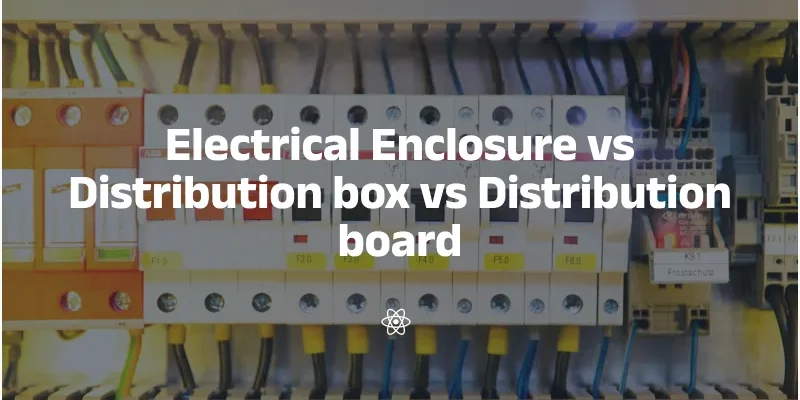الیکٹریکل انکلوژرز، ڈسٹری بیوشن بکس، اور ڈسٹری بیوشن بورڈ برقی نظام میں ضروری اجزاء ہیں، ہر ایک الگ الگ کام اور ایپلی کیشنز پیش کرتا ہے۔ مخصوص ضروریات کے لیے مناسب آلات کے انتخاب کے لیے ان کے اختلافات کو سمجھنا بہت ضروری ہے۔
الیکٹریکل انکلوژر
الیکٹریکل انکلوژر ایک عام اصطلاح ہے جو کسی بھی ڈھانچے سے مراد ہے جو برقی آلات کو ماحولیاتی عوامل جیسے دھول، نمی اور جسمانی نقصان سے بچانے کے لیے ڈیزائن کیا گیا ہے۔ یہ انکلوژرز سائز اور پیچیدگی میں بڑے پیمانے پر مختلف ہو سکتے ہیں اور رہائشی، تجارتی اور صنعتی ترتیبات سمیت مختلف ایپلی کیشنز میں استعمال ہوتے ہیں۔
اہم خصوصیات:
- تحفظ: برقی اجزاء کو ماحولیاتی خطرات سے بچاتا ہے۔
- مواد: عام طور پر دھات یا پلاسٹک سے بنایا جاتا ہے۔
- درخواستیں: مختلف ترتیبات میں استعمال کیا جاتا ہے، بشمول گھروں، فیکٹریوں، اور بیرونی تنصیبات۔
ڈسٹری بیوشن باکس
ڈسٹری بیوشن باکس (DB) ایک قسم کا برقی انکلوژر ہے جو خاص طور پر برقی طاقت کی تقسیم کے لیے ڈیزائن کیا گیا ہے۔ یہ ایک مرکزی نقطہ کے طور پر کام کرتا ہے جہاں مرکزی سپلائی سے بجلی حاصل کی جاتی ہے اور عمارت کے اندر مختلف سرکٹس میں تقسیم کی جاتی ہے۔
خصوصیات:
- سائز: عام طور پر ڈسٹری بیوشن بورڈز سے چھوٹا؛ دیوار پر نصب کیا جا سکتا ہے.
- فعالیت: بجلی کی فراہمی کو محفوظ طریقے سے منظم کرنے کے لیے سرکٹ بریکر، فیوز، اور دیگر حفاظتی آلات رکھے جاتے ہیں۔
- استعمال: عام طور پر رہائشی ترتیبات، اسکولوں اور روشنی اور بجلی کی تقسیم کے لیے چھوٹی تجارتی عمارتوں میں پایا جاتا ہے۔
ڈسٹری بیوشن بکس کی درخواستیں:
- بجلی کی تاروں اور کیبلز کو جوڑنے کے لیے استعمال کیا جاتا ہے۔
- اوورلوڈ تحفظ اور شارٹ سرکٹ کی روک تھام فراہم کرتا ہے۔
- دیکھ بھال کے لیے آسان رسائی کی سہولت فراہم کرتا ہے۔
ڈسٹری بیوشن بورڈ
ڈسٹری بیوشن بورڈ، جسے پینل بورڈ یا بریکر پینل بھی کہا جاتا ہے، ایک زیادہ جدید قسم کا برقی پینل ہے جو متعدد سرکٹس میں بجلی تقسیم کرتا ہے۔ یہ بڑی تنصیبات کے لیے ڈیزائن کیا گیا ہے جس میں کافی پاور مینجمنٹ کی ضرورت ہوتی ہے۔
خصوصیات:
- سائز: عام طور پر تقسیم خانوں سے بڑا؛ فرش پر نصب کیا جا سکتا ہے.
- پیچیدگی: زیادہ بوجھ کی صلاحیت کے ساتھ متعدد سرکٹس کی حمایت کرتا ہے۔ بہتر حفاظت کے لیے بقایا کرنٹ ڈیوائسز (RCDs) جیسی خصوصیات شامل ہیں۔
- استعمال: عام طور پر تجارتی اور صنعتی ماحول میں استعمال کیا جاتا ہے جہاں بجلی کی وسیع تقسیم ضروری ہے۔
تقسیم بورڈ کے کام:
- متعدد سرکٹس پر کنٹرول کو مرکزی بناتا ہے۔
- اوورلوڈز اور فالٹس سے تحفظ فراہم کرتا ہے۔
- اعلی وولٹیج کے نظام کے انتظام کی سہولت فراہم کرتا ہے.
موازنہ ٹیبل
| فیچر | الیکٹریکل انکلوژر | ڈسٹری بیوشن باکس | ڈسٹری بیوشن بورڈ |
|---|---|---|---|
| سائز | وسیع پیمانے پر مختلف ہوتی ہے۔ | چھوٹا (دیوار سے لگا ہوا) | بڑا (فرش پر نصب) |
| فعالیت | عمومی تحفظ | بجلی کی تقسیم | سنٹرلائزڈ سرکٹ کنٹرول |
| عام استعمال | تمام ترتیبات | رہائشی اور چھوٹے کمرشل | تجارتی اور صنعتی |
| اجزاء | مختلف ہوتی ہے۔ | سرکٹ بریکر اور فیوز | سرکٹ بریکر اور آر سی ڈی |
| لوڈ کی صلاحیت | ڈیزائن پر منحصر ہے۔ | کم وولٹیج | ہائی وولٹیج |
نتیجہ
خلاصہ یہ کہ جب کہ تینوں اجزاء برقی نظام کے انتظام کے لیے لازمی ہیں، وہ سائز، فعالیت اور اطلاق میں نمایاں طور پر مختلف ہیں۔ برقی دیواریں عمومی تحفظ فراہم کرتی ہیں۔ ڈسٹری بیوشن بکس چھوٹی سیٹنگز میں بجلی کی محفوظ تقسیم کی سہولت فراہم کرتے ہیں۔ اور ڈسٹری بیوشن بورڈ بڑی تنصیبات میں پیچیدہ برقی نظام کا انتظام کرتے ہیں۔ ان امتیازات کو سمجھنا مخصوص برقی ضروریات کے لیے مناسب انتخاب کو یقینی بنانے میں مدد کرتا ہے۔


